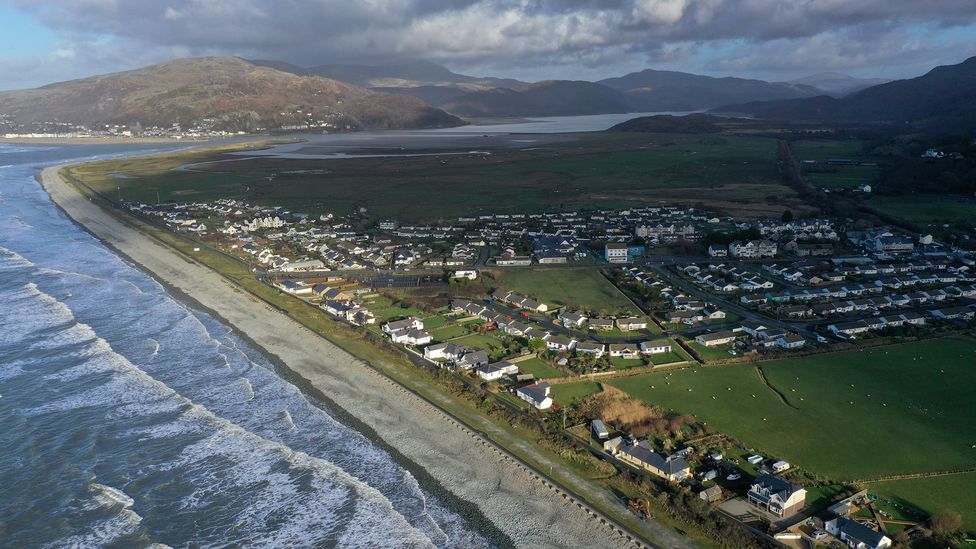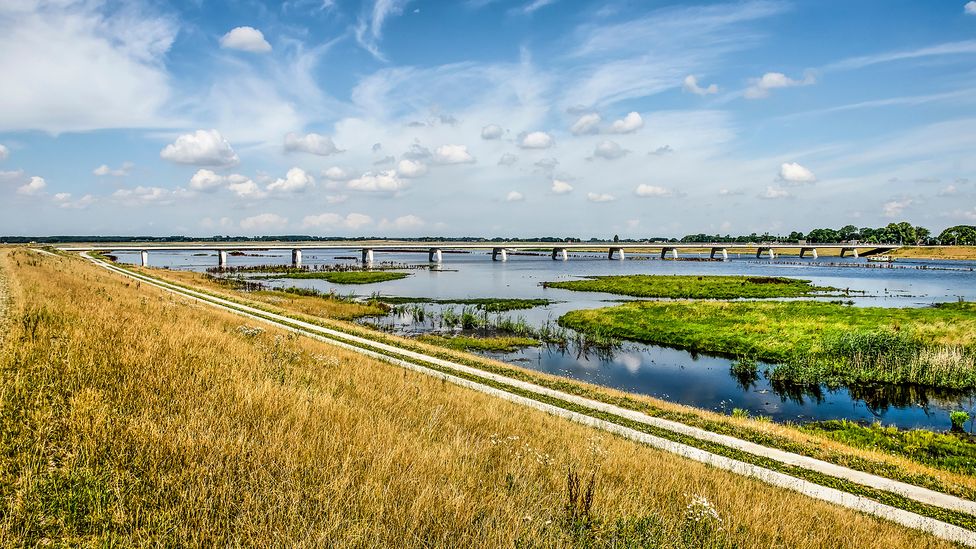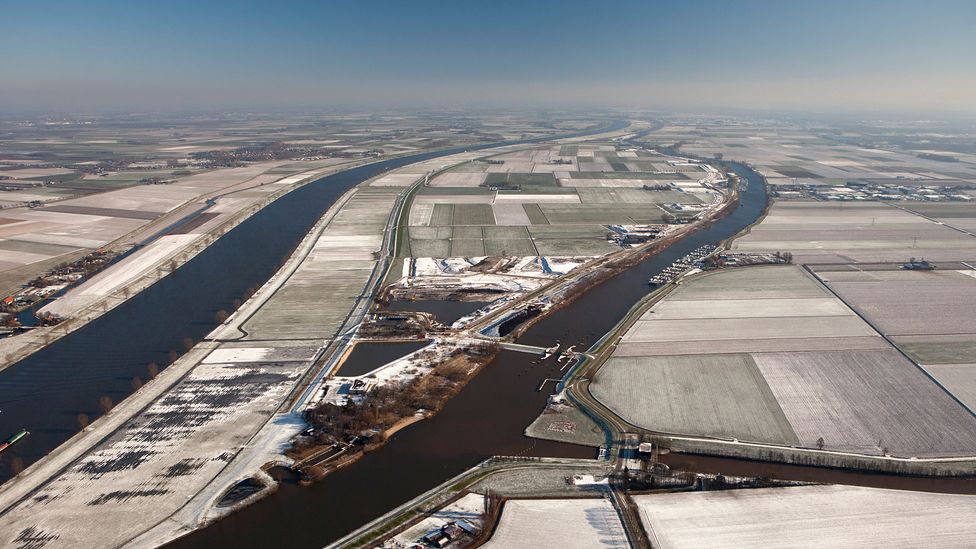Gazing out across the glistening ocean as his dog Lucy races along the beach, 72-year-old Stuart Eaves says there is nowhere else in the world he would want to live.
Eaves has lived in Fairbourne, a tiny Welsh village nestled between Snowdonia National Park and the Irish Sea, for 26 years. He knows everyone in the 700-strong community. He runs the local campsite, and raised his five children here.
“It’s such a lovely place to live. There’s not a lot of money here but it’s got what money can’t buy: peace, tranquillity, security and community,” he says.
But all of that is under threat; Fairbourne is facing an existential crisis. The tiny village has been identified as being at high risk of future flooding because of climate change, with residents told it is beyond saving.
In 2014, Gywnedd Council, which has oversight of Fairbourne, said it would not maintain flood defences indefinitely and that from 2054 the village will no longer be inhabitable. The council plans to “decommission” the entire village, dismantling all homes, roads, shops and infrastructure, and turn it back into marshland.
But Fairbourne residents are refusing to accept that their community is lost to the sea and are furious they have not received any compensation or assistance from the council. Climate experts say that other coastal communities in the UK face a similar fate and that the government must put plans in place to support people who are forced to move because of climate impacts. Some argue the UK could emulate models of flood management from other countries, such as the Netherlands, which has been battling rising water for centuries and has devised a novel approach to tackling the issue.
It’s a question that faces communities all over the world, with hundreds of millions of people facing displacement due to climate impacts by 2050. Finding solutions to help people with losing their homes is becoming an imperative of our age.

Climate models show Fairbourne’s flood risk will increase drastically over the next 30 years. (Credit: Getty Images)
Low-lying Fairbourne is vulnerable to flooding from multiple sources: the sea, a nearby estuary and river run-off flowing down from the hills. The flood risk is projected to increase drastically over the next 30 years.
“The latest forecasts predict that it would not be safe or sustainable to defend Fairbourne beyond 2054,” says a spokesperson for Gwynedd Council. They attribute this to several factors: accelerating sea level rise, an increased likelihood of severe storms caused by climate change, and the unique geological conditions surrounding the village.
Five years ago, Natural Resources Wales (NRW), the organisation responsible for flood management in Wales, spent £6.8m ($8.8m) on strengthening 1.8 miles (2.9km) of concrete tidal defences to protect more than 400 properties in Fairbourne from storm surges and flooding, and to rebuild the outfalls, where the water drains, of the rivers Henddol and Morfa. Defending Fairbourne from flooding requires constant maintenance, with annual costs totalling around £19,000 ($24,000), according to NRW.
“We are fighting nature to provide a level of protection for people,” says Sian Williams, head of operations in North Wales for NRW.
You might also like:
- The mangrove that defied destruction
- The town that got up and left
- The climate benefits of tiny islands
Fairbourne’s first line of defence from the ocean is a shingle bank made of small, round pebbles which has formed naturally since the end of the last ice age 14,000 years ago.
But these defences will not hold back the water forever. Big storms and high tides are eroding the shingle bank, leaving residents exposed to the sea, says Williams. By 2054, sea levels are projected to rise by over 1m (3.3ft) under a worst-case scenario. “2054 is the tipping point when the cost-benefit no longer stacks up to maintain the flood protection systems,” says Williams.
From 2054, the costs of maintaining the flood defences, estimated at £115m ($142m) over the next 100 years by the council, exceed the economic benefits (namely the value of properties) which the council estimates at £70m ($87m).
The villagers are furious at the proposal to abandon the village and have refused to accept that they will be forced to leave behind their homes and community. The council’s decision “has destroyed people’s lives and livelihoods”, says Eaves. “It’s devastating.”
Fairbourne’s residents are not only fearful of losing their homes and jobs. They say the council’s decision also threatens their way of life and community values.
“People here have no fears, we go for a walk when it’s dark and don’t lock our doors,” says Eaves. “Everyone knows each other and talks to each other. If we have to move, we’ve got to abandon this way of life and learn to live in a new way. It’s more than just losing your home; it’s losing your whole identity.”

Stuart Eaves says the council’s decision to dismantle Fairbourne “has destroyed people’s lives and livelihoods” (Credit: Isabelle Gerretsen)
But could there be other options for Fairbourne? In some parts of the UK, communities are taking matters into their own hands due to inadequate government measures to protect them from flooding.
Villagers in Lancashire built their own £100,000 ($125,000) flood defences after they were initially refused government aid in 2016. They made the decision after 100 properties were badly flooded in Churchtown and two neighbouring villages in 2015 following heavy rainfall.
When the council told them that they didn’t qualify for funding, Churchtown residents raised £30,000 ($37,000) to build a clay and brick embankment, designed by local farmers. The Environment Agency then provided the remaining £70,000, saying the embankment was the UK’s only resident-built flood relief scheme.
The embankment, which is maintained by residents, held and kept all houses dry when storms Ciara and Dennis hit Churchtown in 2019, says Siriol Hogg, the founder of the Churchtown Flood Action Group. Hogg had to leave her home for 15 months after it flooded in 2015. “It was terribly distressing,” she says, noting the experience forced her to seek medical support for anxiety. “The people of Fairbourne must be under such mental strain and feeling such grief.”
It’s more than just losing your home; it’s losing your whole identity – Stuart Eaves
Along with other Fairbourne residents, Eaves put forward a proposal last month to Gwynedd Council for the construction of 100 tetrapods – four-legged concrete structures that are used to dissipate the force of incoming waves and prevent coastal erosion. They estimate that it will cost around £50,000 (£62,500). Tetrapods are widely used as coastal defences in Japan. “It would extend the life of the village quite dramatically,” says Eaves.
Installing the tetrapods will be like “creating an artificial reef,” says Angela Thomas, clerk of the community council. “They will take the sting out of waves coming in.”
Thomas says the cost of constructing tetrapods is a “drop in the ocean” compared to the planned spending to dismantle Fairbourne, which could cost an estimated £27m ($34m), according to a demolition and site clearance budget, drawn up by Ultimate Engineering Solutions and seen by BBC Future. “Why is that money not spent on defending Fairbourne?” says Thomas.
Gwynedd Council declined to comment on the specific proposal, saying: “We have a responsibility to carefully consider all the available data and independent expert advice and to discuss the possible options with local people. Ignoring all the evidence of the increasing risks of severe flooding to the community would be irresponsible.”
Living with water
The UK could also look across the channel for inspiration when weighing up whether and how to relocate communities due to increasing flood risk and sea level rise.
“We have said to the council [they] should look at how the Netherlands is managing the water,” says Eaves. “It is one of the wisest solutions: to look abroad and see how others are handling a similar problem.”
For more than 1,000 years, the low-lying Netherlands has been trying to keep water at bay and protect communities from flooding, relying on an elaborate network of dykes. But realising the risks from intensifying climate impacts and rapidly rising water levels, the country changed its long-standing flood strategy in 2006, when it launched the Room for the River programme.
Rather than constantly fighting the water, the aim was to learn to live with it, creating more space for the rivers to grow by lowering floodplains and broadening river channels.
“Whereas we first fought nature… we started thinking instead: how can we restore nature and prepare the country for even more water?” says Hans Brouwer, an engineer at the ministry who led the programme.
The programme also transformed farmland into floodplains. This meant people living near the selected rivers were informed about the flood risk and, in some cases, encouraged to relocate. Approximately 250 households were relocated throughout the 12-year programme.
Many of these people felt similar to Fairbourne residents when they were first presented with the prospect of moving.
“I don’t recall a single project which didn’t start with resistance,” says Brouwer. “But they realised it would not end after Room for the River and that if they don’t adapt their environment now, [flooding] will happen in 20-30 years.”

Some argue the UK should emulate the Netherlands’ flood management model – the low-lying country has been battling rising water for centuries (Credit: Alamy)
Local councils were also given the option to come up with their own alternative plans to tackle water levels in the region. When they were told that staying put long-term wasn’t an option, farmers living in Overdiepse Polder, a low-lying area in the southeast, came up with a novel solution: to build a series of mounds large enough to accommodate new farms and high enough to keep the rising water at bay.
“People didn’t always have to leave their area. When it was possible, new and safe houses were built in the floodplains – for example dwelling mounds,” says Brouwer.
Meanwhile, the people who do decide to move away because of the flood risk can sell their homes to the Dutch government for a “fair price, as if it was in a protected area”, says Brouwer. The government is then responsible for selling the property, assuming it is still safe to inhabit, and bearing the loss, he explains. If people choose to stay in the flood-prone area, the government will cover any damages in the case of flooding, he adds.
Involving the local community in the decision-making process, as well as offering them support with selling their homes and finding a new home or farm, is critical, says Brouwer. Every project is different and it is important that the government takes the time to understand the history, culture and concerns of the local community, and build trust and respect, he says.
Holding the line
Fairbourne residents say they have been unfairly targeted. “We’ve been branded climate refugees,” says Clare Walker-Din. “I don’t think we’re ever going to get rid of that stigma.”
They say other communities facing severe flooding and sea level rise haven’t been told to relocate. “There are places on our coast that are in far more serious straits than we are,” says Thomas.
In fact, 1.2 million homes in England alone, 4% of existing homes, are at 0.5% or greater risk of annual flooding by 2080, according to a 2018 report by the UK Committee on Climate Change (CCC).
Economic damages from flooding and erosion currently cost more than £260m per year on average in England, according to the CCC.
This will rise to £393-£411m ($485-$507m) by 2050 and £529-£582 ($653-$718m) by 2080 under a 2C warming scenario, says Dawson.
We’ve been branded climate refugees – Clare Walker-Din
Despite this economic proposition, the UK government’s default is to “hold the line” and provide protection by constructing and maintaining flood defences.
“There is an optimistic tendency to hope that things will improve in five years, that maybe there will be more money or an injection of support,” says Richard Dawson, professor of earth systems engineering and a member of the CCC’s adaptation committee.
But the CCC report found that holding the line this century is not cost-beneficial for 53-66km (33-41 miles) of coastline. This means that the costs of defending this area of coastline exceed the benefits, which are calculated based on the value of the properties that will be protected by the coastal defences, says a CCC spokesperson.
“Unless there is more money invested, it is unrealistic to expect that the line will be held everywhere,” says Dawson.
Community engagement is key to adaptation plans, he says. “The more time people have to adjust to things, as long as appropriate resources are invested, that mitigates the impacts.”
No plan
None of this has happened in Fairbourne, residents say. Eight years have passed since the council’s decision and they are still waiting to hear about a relocation plan and whether they will receive any financial support.
Thomas says residents have not been offered “a penny of compensation” or any assistance with moving away from Fairbourne. “[My partner and I have] our retirement plan and our pensions, [but] now we’re afraid to spend any money in case we’re turfed out, because there’s no compensation,” she says.
Following Gywnedd Council’s decision, house prices nosedived and banks stopped providing mortgages. During the pandemic, house prices rose again as demand for countryside properties skyrocketed, but the only people who are able to buy are cash buyers who don’t need a mortgage, says Thomas.
But a spokesperson for the council says that ignoring the evidence of the increasing risks of severe flooding to the community would be irresponsible. “We fully appreciate that this is a very difficult situation for local residents and every effort has and will continue to be made to support the community through the process,” they say.
They are looking to commission a health impact assessment to respond to the welfare needs of the community.
Thomas argues that what the council is proposing will make people homeless. “You don’t decommission a village so callously,” she says. “You decommission a nuclear power plant or an old factory.” She would like to see a similar compensation scheme introduced to the one devised by Room for the River. “If there was a [council] offer of compulsory purchase at market value or above, there would be people here who would go for that,” she says.

The Netherlands has helped 250 households relocate to avoid rising water levels, providing them with compensation and assistance (Credit: Alamy)
CARBON COUNT
The emissions from train travel it took to report this story were 13.3kg CO2. The digital emissions from this story are an estimated 1.2g to 3.6g CO2 per page view. Find out more about how we calculated this figure here.
In the meantime, Fairbourne’s residents are staying put.
Kate Hamilton, who lives in Fairbourne with her six children and husband, says she won’t consider moving until her children have grown up and left home.
“We are taking one day at a time. In 10 years we might move, but at the moment, the benefits outweigh the risks,” she says.
Eaves says that more people are moving into the village rather than leaving. “They don’t care about [potential] flooding. They come for peace and quiet,” he says. “The way of life here, you can’t replicate that.”
If moving is the only long-term option, Eaves says the council should buy a large plot of farmland where residents can move in future. “Then people have a plot of land which they can build a house on or they can sell their individual plot and move,” he says.
Relocating everyone to one place is exactly what a tight-knit farming community in Illinois, the US, did in the 1990s. After suffering devastating floods, the entire community left the floodplain and moved uphill, where they rebuilt their town. The town of Valmeyer became an early model of one of the most radical ways to adapt to the climate crisis: moving people and their assets away from danger.
But replicating the “village spirit” will be impossible if Fairbourne residents do have to relocate, says Eaves. “The village works as it is because of where it is.”





















